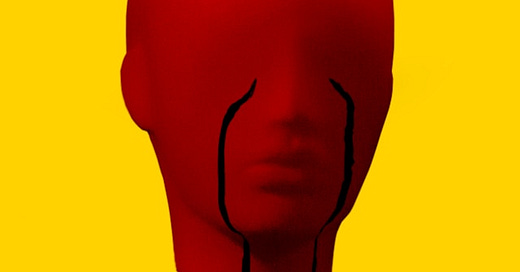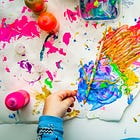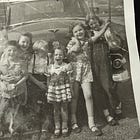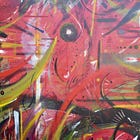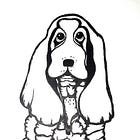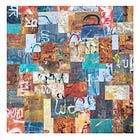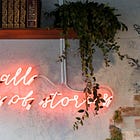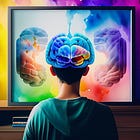17 Creatives Answer: "How do mental health symptoms impact/alter/inspire creative content?"
How does the content of what you create change because of your mental state, life circumstances, the way that your brain works?
These are all excerpts from interviews that I’ve previously shared here, providing insight into the myriad ways that what’s going on in the brain, body and life impacts what we create.

Bunni: It has made me desperate to create a world that is unrealistic. I’ve always been a person that puts my heart and hope into something I want - I mean even the most minute things throughout life. I think that as a result, my mental health has pushed me to create a visible representation of how I would want to be seen if it were possible: A person that’s adventurous, has a sweetness to them, and is actually wanted by someone. Lately, I’ve had a tendency for several of my characters to not have a mouth, which is also stemming from my own mental health trauma of always having to be silent, which progressed into my adulthood. To a degree, it’s creating a reality that if I can’t speak then people would like me more.
Read Bunni’s full interview:
D: As a child, I used drawing to cope with feelings that I didn't understand. I was very depressed. Drawing quietly in my room quickly turned into a way to be "the good child" and to hide in my room to stay away from my parents. At that time, I drew anime and realism. It was my therapy. I felt like I was quickly brainwashed by everybody to think that art was going to be my career. Therefore, it wasn't a hobby anymore; it wasn’t fun anymore. Instead, it was the only thing that people knew me for. I then started to hate drawing for many reasons.Due to how I was growing up, everything had to be perfect the first time. The fear of messing up kept me from really trying different things. I perfected realism throughout time because it was “perfect.” Trying anything different and “messing up” made me afraid of what family and friends would say.
Read D’s full interview:
Tricia: After living with debilitating anxiety for 20 years and then being able to reverse it, I became passionate about sharing my experiences with anxiety and healing it. Because of the mental health stigma, I write openly and honestly about my experiences with anxiety to help break down that stigma and so that others know they are not alone. My mental health symptoms and the situations that create the symptoms are what fuel my writing since I write about mental health and anxiety. I take notes about what I’m going through and share my experiences because I believe we sometimes collectively move through similar feelings and situations. [In terms of other art types:] I’m really drawn to colors I see in nature, especially purple. When I create, whether through my paintings, photographs, or writing, I’m trying to create what feels peaceful and cozy.
Read the full interview with
:I offer a Sliding Scale Pay What You Can annual rate; choose a price that works for you.

Kari: Most of my protagonists are women. I love to tell women’s stories, especially women over 40, who I think are at their most interesting and vibrant. My playwriting mentor and friend - the late, great Tina Howe - said that “Women are still an undiscovered country”, and I think that’s true. I also write stories about the cycle of abuse - both from my own experience, but also the cycle of abuse in America, and how we have not meaningfully coped with trauma. Our nation was founded on trauma, abuse and displacement, and we have still not found a tangible way to integrate this into the fabric of our society and try to do better. To grieve. To try to end it. My play The Worst Mother in the World deals the most directly with mental health, as the protagonist is a woman suffering from postpartum depression. Another play, The Unlikely Ascent of Sybil Stevens, is about a flight attendant who is the sole survivor of a plane crash, and the play explores how that trauma has impacted her life. My most recently completed play, The World I Have Known, focuses on a mother dealing with complicated grief from the loss of a child. Something that binds all these women together is their strength and resilience. Their mental illnesses are not the whole of who they are, but they are part of their journey.
Read the full interview with
:Jenn: Weirdly, I feel like the more I write about my personal stories, the more it helps others. So like: my not-so-great mental health, when expressed well, impacts my readers (and watchers) positively. If that makes sense. Well, I finished a memoir last summer, which centered on my experience of abuse from a narcissistic husband and an exploitative career, in tandem. That went so well (and I’m so happy with the result) that now I write almost exclusively personal essay. And it’s damn good stuff, which is not something I’d have expected even a year ago.
Read the full interview with
:Jane: I've lived with depression all my life, linked, I believe to childhood trauma. I find that I have an attachment to my trauma in that it has been my companion for so many years. It has also (along with depression) given me the impetus to create. I'm often working to find purpose through my writing and, actually, have discovered that deep within the trauma in my soul resides a nugget, a gift, a treasure. So, I guard it carefully and turn to it for inspiration. I've been in and out of therapy and have only found one good therapist who was, himself, a writer. He encouraged me to turn inward, to embrace the fantasies, the stories I carry, and to create from that place. Hence, my memoir (published 2/29/2024), Story Carrier: A Collection of Tales of the Disappeared. I tend to be drawn by darkness. I cultivate dark feelings, sorrow, loss (because it's familiar?) and walk carefully along a line that allows me to feel the darkness without stepping too close to the edge. It's a practice that requires a lot of attention and focus.
Read the full interview with
:
Terry Lee: My second painting done the next day was completely different awash in blue the storm it’s name is about what comes with love. You see I had recently fallen in love with Azure her name for our purpose. And during our romance I created fifteen works still photographing all the way then I went manic and ruined everything by asking Azure to marry me in the most psychotic way. All the paintings show the same pattern of two characters interacting one usually on the right is male on the one on the left is female.
Read Terry Lee’s full interview:
Nessa: I struggle daily with emotions and the way that I process through my feelings. I am a model as well as a published poet and writer, and I create work based on my own experiences and through the use of images in modeling and imagery in writing. When I’m writing, however, I express how I’m feeling through my writing, because often, I am too frustrated or depressed to verbally explain them to others. As a result, communication was and still is a big part of my struggles with depression and anxiety.
Read Nessa’s full interview:
Mya: I started drawing because I was exploring the idea of a book designed for youngsters on the autism spectrum and wondered if I could create the characters myself to be self-sufficient; it transpired that all have this sadness imbued, unwittingly, and I have to dig deep to step away form that. I stick to monochromatic, but that is simply because of my lack of skills! I actually love colours, I'm just not there yet.
Read the full interview with
:Russell: I've been pretty open about my illness since the beginning. I am pretty polarizing as a human, so I'm not sure how that particular axis has affected how people think about me. I will say that because I felt worthless and unlovable for so long, it made me work harder to be helpful. It was the impetus behind most of my non-fiction work, because I figured if I was unlikable but helpful at least people would suffer being around me instead of pushing me away.
Read the full interview with
: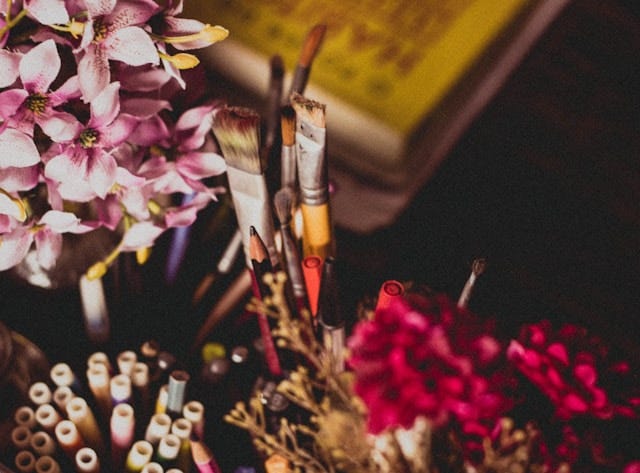
June: After a period of being unwell, one of the things that has always helped me to make sense of it, or to get it into perspective has been to write about it, once I’m well enough to do that. It has always been invaluable and often has been a component of the therapies that I’ve used – talking therapy sessions and then writing down those insights that have come so I can think about them and see how they fit into the unwellness and then the wellness. So I recognise writing as a kind of therapeutic function for me, as well as a creative one. Which is why, I think, my writing contains a lot of myself. I’m not afraid of that exposure any more, because I’ve worked through it in talk and in written word, so creating something new out of it through life writing, in memoir essays for instance, feels positive and productive.
Read the full interview with
:Helen: I was full-time in that final law job and the art became, in hindsight, a defence of myself against the pressure to be someone I was not. It was the counterpart to the public image I was required to hold, the indirect expression of the real me behind the mask I was forced to wear at work. It was also a way to destress and to grow, to become someone interesting and and even a little bohemian behind the black suits! It rounded me out. I was dealing with much material that was harmful and dressing and art was wholesome and nourishing. Much of my art is graffiti inspired. I don’t actually do graffiti (though one day surely I will!) but I have photographed it all over the world and have develeoped a layered style with asemic text and graffiti 'tag' inspired marks. I don't think it is any accident that while I was so silenced by my day job I was so captivated by anonymous public writing. I'm not 100% sure of the link myself but now, as I ponder this question, I think back over my work over the last 12 years or so and I see a lot of fragmentation, uncertainty, secrecy, asemeic text which one could say is about being misunderstood. I cover a lot up, have multiple layers, many hidden and only partially revealed. Recently my art contains Hebrew letters which is very linked to me forming a new identity, to rebuilding myself. Would I be making this work anyway had I not been so ill? Maybe. But I can see a connection and certainly the crisis of mental health was closely entwined with a decision to convert to Reform Judaism, which I had wanted do since late teens. ( I was 49 when I finally did so having blurted out that need in a therapy session to the surprise of both me and my therapist!) I was amazed recently that a piece I made for a show (the piece shown below) that appeared simply abstract with no reference to mental health sold to a psychologist who had never seen my work before. She said she kept being drawn to it, saw something in it. Eventually she said that it was the layer in the middle which was substantially empty compacted to the rest of the work and had some indistinct graffiti marks in it that compelled her to keep returning to it. She said that if she was doing art therapy and someone made this piece she would be asking them what was going in in the centre because 'thats where the personal development is’. She had no idea that when I painted it I started out simply doing an exercise for an art class but by the time I painted the layer she referred to it was very much for me about my nascent emergence from mental illness and feeling towards a different healed life. I though it was amazing how she somehow divined that from an abstract work with no idea of my history.
Read the full interview with
:Lauren: Everything I write (music included) has a certain sadness to it. It’s not all depressing by any means, but there is a little bit of the blues, or a little “dark turn of mind,” as Gillian Welch says, in most of my work. I do not personally suffer from clinical depression, but my mother does and I was raised in a pretty sad household. Still, I think there is a lot of beauty in sadness, so I like to explore it and give it depth in my stories and songs. Not everything sad is entirely sad, nor is everything happy entirely happy. It is the space between that intrigues me.
Read the full interview with
:
Samantha: I think therapy and treatments have allowed me to work in a productive way rather than a chaotic way. What I mean by that is talk therapy often allows me to work through situations to see the true source of the issue, allowing me to use that as a point of reflection and writing. There is a concept in the Episcopal path of spiritual discernment (and others I'm sure) that we cannot discern in a vacuum. It happens in community and in communicating with others. I think that is true for so many ideas.
As far as other treatments, I have been taking medication to help with depression and anxiety for years (stopping only while pregnant with my second child) and it allows me to clear some of the clutter and weight that prevents me from being creative. So rather than throwing things to the wall because I am in a spiral, I am able to intentionally choose what I want to create, rather than creating based on what gets cast off in the chaos. I think some artists work in that way because that is how they work, and I do not work in a way that creates good, meaningful work when I am in that state [of chaos]. I work better when I am able to take a look at the cast off work and intentionally put the content together. I have also written about my experience with ketamine treatment on Substack which I am looking forward to exploring more.
Read the full interview with
:Key Ocho: In hindsight, I was a highly sensitive, empathic child (still highly sensitive). Although I had everything I needed as a child, the energy in my household was consistently chaotic. I was afraid of verbally describing that and thought I would be punished if I expressed that. I constantly walked on eggshells around my father; my mother was my protector.
Around eight, I started receiving notebooks and diaries as gifts. Watching 90s sitcoms of teenagers writing in their diaries piqued my interest in privately expressing myself. I knew there were no consequences or limits. This served as my permission slip to write honestly and authentically. I had no advanced vocabulary to express myself at that age, but it was a start. Through writing, I could acknowledge my feelings instead of feeling like they were being dismissed; I also noticed patterns of what I kept writing about and what was bothering me. Writing about these things at a young age also helped me to practice how I wanted to express myself to my parents, family members, and friends. I felt a sense of safety while writing: no one could hurt me, judge my thoughts, or shut them down. This was my way of expressing my fears, frustrations, hopes, and dreams. I also used writing to escape reality with fiction and fantasy stories of the life I wished I had: living in a castle with a pet unicorn in an imaginary land.
Read the full interview with
:Loreteller: My approach to characters is certainly informed by my own experiences. My whole life has been underpinned by the idea that people can change dramatically and for the better. The single hope I held onto in my childhood was that one day my parents would change who they are. They didn’t, but it was that hope that meant everything to me. I have done so much interior work trying to understand how change works and how to effect positive, lasting change in myself. When it comes to my characters, I tend to begin with them stuck in a frame of reference that they are comfortable with - perhaps even addicted to. Through trials and obstacles, I bring them to a place of enlightenment, where they see beyond the constructs of their prior world.
Read the full interview with
:
AF: “Life-long compulsive artist for personal and professional use. I typically paint, draw or do collage/mixed media, but really just enjoy experimenting with a lot. First diagnosed with depression as a teenager due to parents concerned by bloody/depressing content of my art. I’ve been diagnosed with PTSD more recently, but have always used art as a sort of therapy/journaling. Creating art induces a meditative state for me that helps when I am overwhelmed or distressed. Art for me is also the way I see/perceive things with heightened awareness and focus, not just the process of converting these visions into something physical in order to document these experiences for myself or communicate my emotions to others.” So intrigued by how the content of art concerned the parents and alerted them to the artist’s depression, but then also this content was a form of self-expression that helped to receive the symptoms of that depression. “I have many different styles; it is definitely affected by what mental state I am in. When upset, my drawings are more shaky and less accurate, even child-like sometimes … maybe due to regression. When I feel more balanced, relaxed and in touch with all my emotions, I am more satisfied with the balance in my composition and color in art. My imagery is all over the place, from gruesome and dark to pleasant/pretty. I particularly like combining everything as much as possible.”
Read the full interview with A.F.:
Summary
In wrapping up, it's clear from these interviews just how deeply mental health impacts creative content, but also in how many different ways. We all have a lot in common but also we are each unique. Artists like Bunni, Tricia, Kari, and Jenn illustrate how their personal struggles and triumphs become woven into the fabric of their art, transforming trauma into powerful narratives. Others, like Samantha and A.F., show how therapy and medication can guide chaotic creativity into intentional and meaningful expression. Each person offered something so valuable here and I’m so humbled and grateful for the time they spent sharing their thoughts with me.

